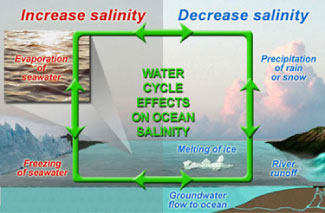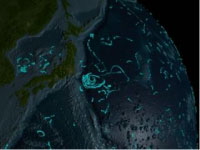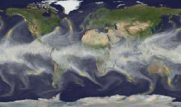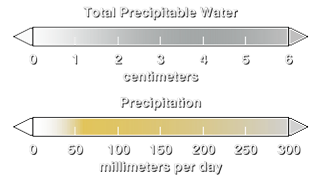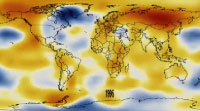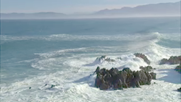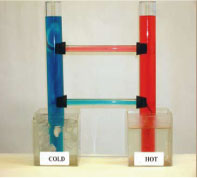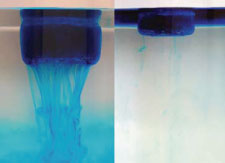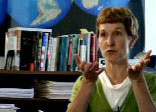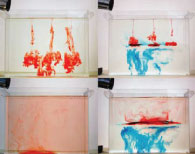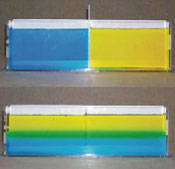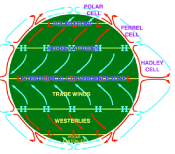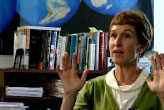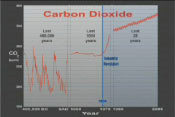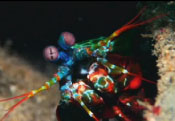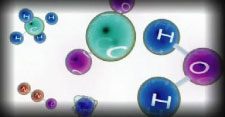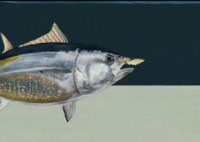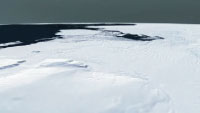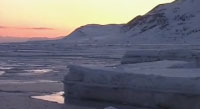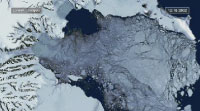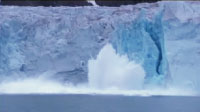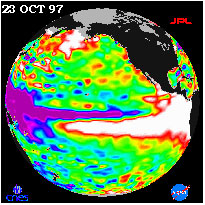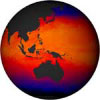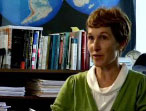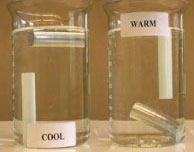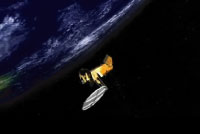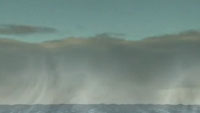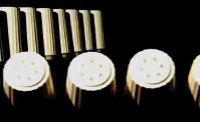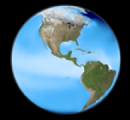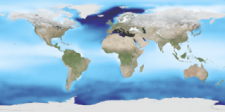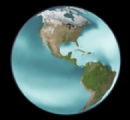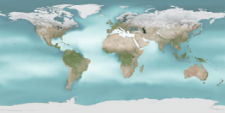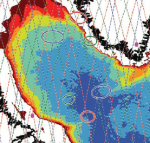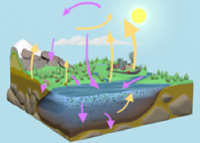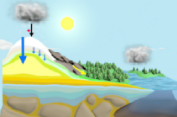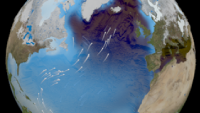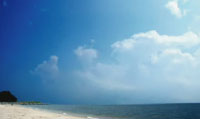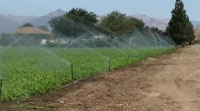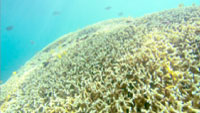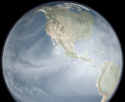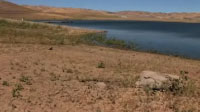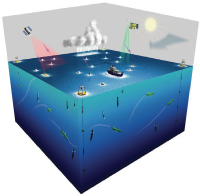 |
NASA | GSFC | JPL | Site Map |
|
|
 |
 |
Education: Student Outcomes |
Filtered by grade level: 9-12 Click here to begin a new search | ||||||||||||||||||||
Grade levels: 5-8, 9-12 Theme: water cycle Tool: http://aquarius.nasa.gov/education-datatools.html
Salinity patterns are governed by geographic differences in the "water budget." For example, like on continents, some areas of the ocean are rainy whereas others are arid and "desert-like." To learn more about the factors that influence salinity patterns, we invite you investigate five pairs of data maps centered over the North Atlantic Ocean (listed below). Each map shows monthly conditions based on long-term averages. The challenge is to find the data set that most closely corresponds to sea surface salinity patterns. Grade level 5-8: Look at monthly maps of: air temperature vs. sea surface salinity and precipitation vs. sea surface salinity. Are any of these data sets closely correlated with solar energy input (e.g., seasonal change)? Grade level 9-12: For the North Atlantic Ocean, look at monthly maps of air temperature vs. sea surface salinity and precipitation vs. sea surface salinity and evaporation vs. sea surface salinity. Are changes in these data sets closely correlated with solar energy input (e.g., seasonal change) in the North Atlantic ocean? Look at these videos -- Sea Surface Salinity and Components of the Water Cycle for global data sets of sea surface temperature, precipitation, and evaporation. | ||||||||||||||||||||
Grade levels: K-4, 5-8, 9-12 Themes: 21st century technology, ocean circulation, water cycle Flat Tool: http://ourocean.jpl.nasa.gov/AQUARIUS/chp2.jsp GoogleEarth Interface Tool: http://aquarius.jpl.nasa.gov/AQUARIUS_DEV/chp2.jsp Create global maps of mean conditions for any month at designated depths (down to 1500m) using the pull-down menus. Monthly time-series graphs of salinity, temperature, or density can be plotted by selecting up to six locations (by clicking on the map or typing latitude/latitude information into the fields below). These time-series graphs can also represent up to six different depths. Plotted data will also be shown in a table that is easily downloaded (e.g., into Excel). Sources include interpolated atlas data or actual measurements from the database. Focus Questions | Flat Tool Tutorial | ||||||||||||||||||||
Grade level: 9-12 Theme: 21st century technology Video: aquarius_passive_satellilte.flv One thing to note about the Aquarius satellite is that it's what we call a "passive" satellite. Even though it takes a lot of work to get up there and a lot of people are working to put it up there, what it's doing is actually recording the wavelengths that the earth is radiating. So some satellites are "active": so they are sending a signal down through the atmosphere to earth's surface and then they are recording that signal that comes back. But when we're trying to measure the sea surface salinity, the Aquarius satellite will be recording the microwaves that the earth is sending back out to the atmosphere and space. | ||||||||||||||||||||
Grade level: 9-12 Theme: 21st century technology Video: argo07_640x480.flv
This visualization shows the locations of the ARGO buoy array over time. When the buoys are above water, the lines are brighter; when the buoys are under water, the lines are fainter. The ARGO buoys measure ocean salinity, column temperature, and current velocities. (source) | ||||||||||||||||||||
Grade level: 9-12 Theme: ocean circulation Video: elnino-320.flv
These data are from the Goddard Earth Modeling System, a coupled land-ocean-atmosphere model which uses earth and satellite-based observations to simulate the Earth's physical system during events such as El Niño. (source) Compare this video with Components of the Water Cycle: Flow of Atmospheric Water Vapor. | ||||||||||||||||||||
Grade levels: 5-8, 9-12 Themes: 21st century technology, climate, water cycle Flat Tool: http://ourocean.jpl.nasa.gov/AQUARIUS/chp3.jsp GoogleEarth Interface Tool: http://aquarius.jpl.nasa.gov/AQUARIUS_DEV/chp3.jsp Create global maps of mean conditions for any year(s) from 1800 to 2005 at designated depths (down to 1500m) using the pull-down menus. Annual time-series graphs of salinity, temperature, or density can be plotted by selecting up to six locations (by clicking on the map or typing latitude/latitude information into the fields below). These time-series graphs can also represent up to six different depths. Plotted data will also be shown in a table that is easily downloaded (e.g., into Excel). Source is actual, non-interpolated database measurements. Focus Questions | Flat Tool Tutorial | ||||||||||||||||||||
Grade level: 9-12 Theme: water cycle Video: global_ocean_04.flv
Paula Bontempi: "If the climate actually changes, and the oceans change or respond to that change, it most definitely will impact life as we know it, and especially humans." David Adamec: "To understand exactly how we stay here and how we're going to survive both within the climate, and even our life cycle, it requires understanding what the water is doing." Our climate is changing... in some places, faster than predicted. By using science to understand those changes, we can find ways of protecting our oceans - and ourselves - that make a world of difference. | ||||||||||||||||||||
Grade level: 9-12 Theme: water cycle Video: global_ocean_03.flv
Other satellites show us peaks and valleys, not just on land - but, believe it or not - on the surface of the ocean. And as ice on land melts, there are increasingly more highs than lows. Sea level is rising. | ||||||||||||||||||||
Grade levels: K-4, 9-12 Theme: 21st century technology Video: global_ocean_01.flv
Paula Bontempi: "You can see the atmosphere, you can see the land, but you can't really see beneath the ocean's surface. So you start wondering, you know, what's going on beneath the part we can see." David Adamec: "We walk in a very small part of the atmosphere, and we walk on the land. And it's how that interaction takes place with the ocean, the atmosphere, and the land that determines our quality of life. Our goal is to understand the interconnectedness of it all." For years, people have worked to unravel the mysteries of the oceans. Scientists gather data from ships and buoys on the surface, take the plunge to explore ocean depths, and fly overhead to get a bigger picture. But one of the best views of oceans might be from way, way overhead. It's the view from space. Paula Bontempi: "The one thing that NASA satellites do that nothing else does, ships or buoys or anything else, is actually give you a picture of the globe within a few days. You get a much broader view of what's going on in some part of the Earth's system, and you can link that together to understand the Earth as a whole." | ||||||||||||||||||||
Grade level: 9-12 Theme: 21st century technology Video: global_ocean_02.flv
David Adamec: "We are dependent on life in the water. Especially in the ocean. There are small plants called phytoplankton that are responsible for 50 percent of the oxygen that you're breathing right now." | ||||||||||||||||||||
Grade levels: 5-8, 9-12 Themes: climate, ocean circulation Activity: http://www.tos.org/hands-on/teaching_phys_concepts.pdf
The purpose of this activity is to review basic concepts of thermal physics and highlight applications to ocean processes by focusing on the concept of convection. Convection and advection are the major modes of heat transfer in the ocean and atmosphere. Convection occurs only in fluids and involves vertical motion of fluid, or flow, rather than interactions at the molecular level. It results from differences in densities - hence buoyancy - of fluids. Examples of convective processes include: currents in Earth's mantle, which drive the tectonic system and result from heating and cooling of magma; atmospheric circulation resulting from uneven solar heating (e.g., between the poles and the equator); the global ocean conveyor belt and formation of deep water masses, resulting from cooling of surface water at high latitudes; and vertical mixing in the ocean's upper layer due to variations in heating between day and night. Advection usually refers to horizontal transfer of heat with the flow of water (e.g., the Gulf Stream). Read the following sections of Chapter 4 (Heat and Temperature) in preparation for this activity: • Background (p. 32) • Mechanisms of Heat Transfer (p. 33) Videos
Flash Video | QuickTime Movie
| ||||||||||||||||||||
Grade level: 9-12 Theme: water cycle Activity: http://www.tos.org/hands-on/teaching_phys_concepts.pdf
In the left panel in the photo at right, an ice block floats in tap water because the density of ice is lower than that of freshwater. As the ice melts, however, cold, colored meltwater sinks to the bottom because it is denser than the tap water. Warmer water from the bottom is then displaced and upwells, resulting in a convective flow visible in the dye patterns. Ice melting in the center of the tank is analogous to a convection "chimney" formed in the open ocean, while ice melting at the tank's edge is analogous to a chimney on a continental shelf (near a land mass). Such chimneys in the ocean, created and sustained by convective processes, appear as "columns" of mixed water that flow downwards. For a given set of oceanic and meteorological conditions, open-water convection tends to entrain (mix with) more of the surrounding waters than does convection near a land mass. The open-ocean case therefore results in downwelled water that is less dense. In the right panel, the ice block floats in dense, salty water. As the ice melts, only a small amount of dye sinks because the density of the saltwater is greater than the density of the newly melted, fresh, ice-cold water. Most of the meltwater accumulates in a surface layer on top of the denser salt layer. Read the Background section (p. 4-5) of Chapter 1 (Density) in preparation for this activity. Note: Even though this experiment focuses on temperature only, it can be used to discuss how salinity, like temperature, affects the density of ocean water. | ||||||||||||||||||||
Grade levels: 5-8, 9-12 Theme: ocean circulation Video: density_effects.flv
But in the ocean it often happens that the reverse happens: so we might get something that's heavy, heavier (like) more dense waters on top of lighter water. And when that happens, we say that the ocean is unstable and we have "overturning". That means that the waters that are heavy come down to the bottom part of the ocean and those that are light need to go up. And that happens when waters are cooled and it also happens when the upper waters get saltier because of evaporation, etc. So those density differences mean that the ocean is going to circulate: it's going to move. And those density differences can come about because of temperature changes or salinity changes. | ||||||||||||||||||||
Grade level: 9-12 Theme: 21st century technology Design your own experiment based on the activities conducted for the following outcomes:
| ||||||||||||||||||||
Grade level: 9-12 Theme: water cycle Activity: http://www.tos.org/hands-on/teaching_phys_concepts.pdf
Mixing of stratified layers requires work. Without energetic mixing (e.g., due to wind or breaking waves), the exchanges of gases and nutrients between surface and deep layers will occur by molecular diffusion and local stirring by organisms, which are slow, ineffective modes of transfer. The energy needed for mixing is, at a minimum, the difference in potential energy between the mixed and stratified fluids. Therefore, the more stratified the water column, the higher the energy needed for vertical mixing. Density is fundamentally important to large-scale ocean circulation. An increase in the density of surface water, through a decrease in temperature (cooling) or an increase in salinity (ice formation and evaporation), results in gravitational instability (i.e., dense water overlying less-dense water) and sinking of surface waters to depth. Once a sinking water mass reaches a depth at which its density matches the ambient density, the mass flows horizontally, along "surfaces" of equal density. This process of dense-water formation and subsequent sinking is the driver of thermohaline circulation in the ocean. It is observed in low latitudes (e.g., the Gulf of Aqaba in the Red Sea, the Gulf of Lions in the Mediterranean Sea) as well as in high latitudes (e.g., deep water formation in the North Atlantic). This experiment looks at the energy required to mix two layers. Students should read the Background section (p. 4-5) of Chapter 1 (Density) in preparation for this activity. Videos
Flash Video | QuickTime Movie | ||||||||||||||||||||
Grade levels: 5-8, 9-12 Theme: ocean circulation Activity: http://www.tos.org/hands-on/teaching_phys_concepts.pdf
Stratification forms an effective barrier for the exchange of nutrients and dissolved gases between the top, illuminated surface layer where phytoplankton can thrive, and the deep, nutrientrich waters. Stratification therefore has important implications for biological and biogeochemical processes in the ocean. For example, periods of increased ocean stratification have been associated with decreases in surface phytoplankton biomass. In coastal waters, prolonged periods of stratification can lead to hypoxia (low oxygen), causing mortality of fish, crabs, and other marine organisms. This activity compares salt and fresh water, demonstrating that fluids arrange into layers according to their densities. Students in grades 9-12 should read the Background section (p. 4-5) of Chapter 1 (Density) in preparation for this activity. Videos
Flash Video | QuickTime Movie | ||||||||||||||||||||
Grade levels: 5-8, 9-12 Theme: ocean circulation Activity: http://www.tos.org/hands-on/teaching_phys_concepts.pdf
Stratification forms an effective barrier for the exchange of nutrients and dissolved gases between the top, illuminated surface layer where phytoplankton can thrive, and the deep, nutrientrich waters. Stratification therefore has important implications for biological and biogeochemical processes in the ocean. For example, periods of increased ocean stratification have been associated with decreases in surface phytoplankton biomass. In coastal waters, prolonged periods of stratification can lead to hypoxia (low oxygen), causing mortality of fish, crabs, and other marine organisms. This activity compares warm and cold water, demonstrating that fluids arrange into layers according to their densities. Students in grades 9-12 should read the Background section (p. 4-5) of Chapter 1 (Density) in preparation for this activity. Videos
Flash Video | QuickTime Movie | ||||||||||||||||||||
Grade level: 9-12 Theme: ocean circulation Article: documents/21.1_yashayaev.pdf The Labrador Sea is the coldest and freshest basin of the North Atlantic. Winter cooling in this sea produces Labrador Sea Water. This intermediate water plays an important role in the exchange of heat, freshwater, and other substances between the atmosphere and the abyssal ocean, affecting the water masses, circulation, and, ultimately, climate of the subpolar North Atlantic basins. The subpolar gyre of the North Atlantic has exhibited large changes in temperature, salinity, and volume over the past six decades, largely in response to changing winter conditions over the Labrador Sea. The signature of these changes can be seen in the lower limb of the Meridional Overturning Circulation down into the North Atlantic tropics. Read and discuss the Abstract and Introduction (p. 30-32). | ||||||||||||||||||||
Grade level: 9-12 Theme: 21st century technology Video: aquarius_launch.flv Aquarius is going to be launched later this year. And one of the great things about it is that it has been in planning for a number of years and the launch is very exciting to all of those of us who have been working on it and looking forward to the launch. The main thing about it is that it is going to be giving us more data. So anybody who works in studying the oceans, the atmosphere, or the land on large scales is always interested in getting back more data. Because that just tells us a lot more about how the earth is working. | ||||||||||||||||||||
Grade level: 9-12 Theme: climate Activity: http://www.pbs.org/newshour/extra/teachers/lessonplans/science/jan-june08/polar_oceanography.html
Part III: Ocean Currents and Coastal Climates. Do ocean currents affect coastal climates? Resources provided with this activity enable students to access climatic data for two communities: St. Mawgan, England, and Daniels Harbour, Newfoundland, Canada. Both communities are located near 50°N latitude. St. Mawgan is situated on the southwestern coast of England along the eastern shores of the Atlantic Ocean. Daniels Harbour is located in Newfoundland near the western shores of the Atlantic Ocean. Students will collect, process, and analyze climate data to answer questions on temperature patterns, prevailing winds, and the Gulf Stream. | ||||||||||||||||||||
Grade level: 9-12 Theme: 21st century technology Video: getting_full_picture.flv Up until now when we've been trying to understand how density changes impact ocean circulation, we've really just had half the picture. Because we've just be able to look at our global coverage of temperature. But with the Aquarius mission, we'll be able to complete that other half. We'll be able to look at the salinity information; and the salinity combined with temperature will give us the information about the density field. | ||||||||||||||||||||
Grade level: 9-12 Theme: 21st century technology Video: how_aquarius_works.flv
But some of that energy comes back at wavelengths that are micro-wavelengths. And the microwave lengths - the amount of energy that's emitted by the ocean - depends on the salinity. It is related to something we call the "brightness temperature". It all has to do with how much energy is emitted from the ocean back to the atmosphere, back out to space. And so if a satellite is sitting there, it's actually recording how much energy in that microwave segment is being emitted. And by the signal that it receives, it's able to "back out" (i.e., calculate) what the ocean salinity is. | ||||||||||||||||||||
Grade level: 9-12 Theme: climate Article: documents/v39n2-schmitt_2174.pdf As with similar questions about a tree in the forest or a grain of sand on the beach, it may be hard to imagine that a few inches of rain matters to the deep ocean. After all, the ocean's average depth is around 4 kilometers and only 1 to 5 centimeters of water are held in the atmosphere at any one time. But it does matter, in part because the ocean is salty. The effect of rain diluting the salts in the ocean (or evaporation concentrating them) can be greater than the effect of heating (or cooling) on the density of seawater. | ||||||||||||||||||||
Grade level: 9-12 Themes: climate, water cycle Video: keeping_up_carbon_03.flv
Researchers are learning that future climate change will depend on carbon levels in the land, in the atmosphere, and in the sea, and how these levels respond to human disturbance. About one-third of all human-generated carbon emissions has dissolved into the ocean. More than 80% of Earth's added heat is now stored in the ocean. Scott Doney: "In the future, as the planet gets warmer, the water's going to warm up, and warm water can hold less carbon than cold water - the other thing is, on a warmer planet, some of the currents are going to slow down, so we might not be forming as much of this cold deep water. So we won't be able to transport carbon into the deep sea. So on the whole, the ocean's going to become less effective at removing carbon from the atmosphere." (source) | ||||||||||||||||||||
Grade level: 9-12 Themes: climate, water cycle Video: keeping_up_carbon_04.flv
Stacey Boland: "As the ocean absorbs more carbon dioxide, it becomes more acidic, and this can be a threat to some of the organisms that live inside the ocean." As Earth's climate continues to change, how will researchers monitor something as big as the ocean, and something as complex as the carbon cycle? NASA Earth observing satellites give scientists the "big picture" view of our home planet. Varied satellites help researchers detect changes in ocean climate and ecology over time, providing vital insight into the health of our home planet. (source) | ||||||||||||||||||||
Grade level: 9-12 Theme: climate Video: keeping_up_carbon_01.flv
Understanding the carbon cycle - and how it is changing - is key to understanding Earth's changing climate. On land, plants remove carbon from the atmosphere through photosynthesis. Animals eat plants and either breathe out the carbon, or it moves up the food chain. When plants and animals die and decay, they transfer carbon back to the soil. Moving offshore, the ocean holds huge amounts of carbon - about 50 times the amount we find in the atmosphere. Stacey Boland: "The ocean is sometimes called a carbon sink, meaning that it absorbs, or takes up carbon from the atmosphere. It takes up carbon through physical and biological processes." (source) | ||||||||||||||||||||
Grade level: 9-12 Theme: climate Video: keeping_up_carbon_02.flv
Over long time scales, this process has made the ocean floor the largest reservoir of carbon on the planet. Most of the ocean's nutrients are in cold, deep water. In a process called upwelling, currents bring nutrients and carbon up to the surface. Carbon can then be released as a gas back into the atmosphere, continuing the carbon cycle. By cycling huge amounts of carbon, the ocean helps regulate climate. Scott Doney: "So when you think of climate, you don't often think of the ocean. With climate - you think of, is it going to be hotter this year, or is it going to be colder this year? But the oceans are actually a great regulator, a controller of Earth's climate. And they even are controlling how much carbon is in the atmosphere, which can slow down how quickly climate change is occurring." (source) | ||||||||||||||||||||
Grade level: 9-12 Themes: climate, ocean circulation, water cycle Video: melting_ice_03.flv
Lora Koenig: "Even though the polar regions seem very far from a lot of people's day to day life, they are very important. Because they are regions that cool our earth. And as they change, they're going to cause larger changes throughout the rest of the globe." (source) | ||||||||||||||||||||
Grade level: 9-12 Themes: climate, ocean circulation, water cycle Video: melting_ice_02.flv
Lora Koenig: "What we're seeing right now on the ice sheets and glaciers is that they are shrinking in size. And as glaciers on land are shrinking overall, that contributes a little bit to sea level rise. And we are worried that as we see warming over the ice sheets, and increased melting over the ice sheets, that they are going to start contributing much more to sea level rise." (source) | ||||||||||||||||||||
Grade level: 9-12 Themes: climate, ocean circulation, water cycle Video: melting_ice_04.flv
Josh Willis: "As the great ice sheets in Antarctica and Greenland begin to melt and break up due to global warming, we really might experience very rapid sea level rise; three or four times as fast as the rate that we see today. So predicting this rate out into the future is very tricky because we really don't know when the ice sheets might break up and how fast they will when they do. So predicting future sea level rise is one of the great scientific problems of the future." (source) | ||||||||||||||||||||
Grade level: 9-12 Themes: climate, ocean circulation, water cycle Video: melting_ice_01.flv
Josh Willis: "I prefer not to think about climate change and global warming in terms of doom and gloom scenarios, so much as a change in our planet. Our planet's definitely changing, and we're definitely causing it. So we're going to have learn to deal with some of these changes. But in addition, we're going to have to learn how to make a slightly smaller footprint on our planet." Josh Willis: "Sea level is rising effectively because of global warming. As the planet heats up, two things happen to the ocean. One is that the temperature of the water increases. And as that happens, the water actually expands and takes up more room. The other thing that happens is that ice that was on land in the form of glaciers and ice sheets begins to melt and as that runs off into the ocean, it increases the water in the ocean, and it actually raises sea level as well. (source) | ||||||||||||||||||||
Grade level: 9-12 Theme: climate Activity: http://mynasadata.larc.nasa.gov/preview_lesson.php?&passid=9 The purpose of this activity is to discover the link between ocean temperatures and currents as related to our concern for current climate change. After completing this activity, students will:
| ||||||||||||||||||||
Grade level: 9-12 Theme: ocean circulation Tool: http://mynasadata.larc.nasa.gov/preview_lesson.php?&passid=68
It is believed that El Niños occur every two to eight years, and are sometimes stronger, sometimes weaker. This often happens when the southeast trade winds weaken or even reverse. As a result, large masses of water from the western Pacific Ocean migrate to the east to the coast of South America. This change in ocean circulation not only impacts the weather and climate in South America, but also affects locations all around the globe. These effects can last for about a year, when the opposite conditions occur as the trade winds strengthen again, and the waters off the coast of South America are colder than normal from active upwelling occurring along the coast. This phase of the global circulation disruption is called La Niña. We have been fortunate over the last 30 years to have satellite and buoy data to warn us if the El Niño phase is upon us. By measuring sea surface heights with satellites like TOPEX Poseidon, sea surface temperature with satellites like AVHRR, and wind vectors from buoys and satellites, we can monitor the Pacific Ocean for changes that may signal the onset of El Niño or La Niña. The sensitive altimeter on the TOPEX Poseidon satellite can measure small changes that create hills and valleys on the sea surface which is mostly caused by thermal expansion (steric effect), and the warming of the ocean during an El Niño event can be sensed by the altimeter. This lesson explores El Niño by looking at sea surface temperature, sea surface height, and wind vectors in order to seek out any correlations there may be among these three variables. It employs group work where different teams work together to analyze a single variable, and then get together in different groups to compare all three variables. The lesson will guide students through data representing the strong El Niño from 1997 to 1998. By doing this, students will model the methods of researchers who bring their expertise to study integrated science questions. Depending on the classroom dynamics, available technology, and available time, this lesson may be modified. | ||||||||||||||||||||
Grade levels: 5-8, 9-12 Themes: climate, ocean circulation Tool: http://oceanmotion.org/html/resources/oscar.htm This data visualizer gives access to the following global ocean surface current behaviors between 1992 and 2008: current speed, current direction, current convergence, and current vorticity as well as the anomaly values for each. | ||||||||||||||||||||
Grade level: 9-12 Theme: ocean circulation Article: http://www.nasa.gov/centers/goddard/news/topstory/2003/0114salt.html
This study, conducted for NASA by University of Maryland researchers Joaquim Ballabrera, Tony Busalacchi, and Ragu Murtugudde, is one of the first to look at ocean salinity in El Niño, Southern Oscillation (ENSO) predictions and their relationship to tropical sea surface temperatures, sea level, winds, and fresh water from rain. | ||||||||||||||||||||
Grade level: 9-12 Theme: 21st century technology Video: aquarius_catch_up.flv
But with the ocean, the ocean has been much more inaccessible. It has been inaccessible because it's very far away from where people live, it's very deep, and it's also it's very salty which means it has been a very corrosive environment for instruments. But what we're able to do now with satellite measurements is get a lot of data over large areas of space and continuously in time. And that information about the salinity, coupled with the information we have about the ocean temperatures because of the NASA satellites, really helps us learn a lot more about the ocean, and the ocean circulation. So one day we will also be able to make predictions about ocean circulation. | ||||||||||||||||||||
Grade level: 9-12 Theme: water cycle Activity: http://www.tos.org/hands-on/teaching_phys_concepts.pdf
Thermal expansion is the principle by which a liquid thermometer works. In the ocean, thermal expansion is thought to contribute significantly to sea level rise on decadal-to-century-long time scales. However, thermal effects appear to be influenced by decadal climate-related fluctuations, making it difficult to estimate the long-term contribution of thermal expansion to sea level rise. Current estimates suggest that thermal expansion is responsible for 25 percent to 50 perccent of observed sea level rise. In this activity, we look at thermal expansion using two rods, one made of aluminum and the other made of PVC. When placed in cold water, both rods initially float because their densities are lower than that of the cold water. Over time, the PVC rod gets colder and contracts, which results in a density change. When the density of the rod exceeds that of the water, the PVC sinks. The aluminum rod gets colder too, but aluminum expands and contracts much less than PVC when its temperature is changed by the same amount; therefore, the aluminum rod's density is less affected by the temperature change, and it remains floating. Students will also try this experiment with hot water. Videos
Flash Video | QuickTime Movie | ||||||||||||||||||||
Grade level: 9-12 Theme: water cycle Article: documents/21.1_schmitt.pdf Articles in this salinity-themed Oceanography issue articulate the potential of our rapidly expanding ability to measure salinity to enhance understanding of the global water cycle. Read and discuss the first three sections (p. 12-15) of this article. | ||||||||||||||||||||
Grade level: 9-12 Theme: water cycle Video: salt_of_earth_04.flv
Susan Lozier: "Up until now when we've been trying to understand how density changes impact ocean circulation, we've really just had half the picture." When the Aquarius / SAC-D satellite is launched, scientists can look at salinity of the surface of the ocean from 400 miles above the earth. Susan Lozier: "But now with the Aquarius mission, we'll be able to complete that other half. We'll be able to look at the salinity information. And so salinity, combined with temperature, will give us the information about the density field." The satellite will gather more salinity data than in the last 125 years. This mission will help scientists better understand how salinity and ocean circulation are tied to global climate and how both systems are changing throughout time. (source) | ||||||||||||||||||||
Grade levels: 5-8, 9-12 Themes: climate, ocean circulation, water cycle Video: salt_of_earth_03.flv
Jeff Halverson: "Climate change on earth is complicated by the fact that the ocean moves much more slowly than the atmosphere. So you have warming in the atmosphere, warming in the ocean, but they're occurring at different speeds. So they're out of sync, and that makes predicting what's going to happen in the next hundred or two years very, very difficult." Susan Lozier: "Now what we might expect happens, in a very simplistic sense, is that as the ocean warms, there's going to be more evaporation. And that more evaporation would would mean that oceans become saltier. But really it's not just that simple because there's also evaporation, precipitation, and the ice as well, and that's all wrapped up in the study of the hydrologic cycle." (source) | ||||||||||||||||||||
Grade levels: 5-8, 9-12 Themes: climate, ocean circulation, water cycle Video: salt_of_earth_02.flv
Jeff Halverson: "It takes perhaps a thousand years for the water to cycle through the deep ocean. So we say the oceans have a memory. They're like a tape recorder. Things that happen now will still be manifest hundreds of years in the future as that cold water moves through this giant circulation." Susan Lozier: "So if there's any change to that overturning circulation, that means that Northern Europe and the British Isles would be robbed of that heat due to those waters that are returning to the high latitudes." (source) | ||||||||||||||||||||
Grade levels: 5-8, 9-12 Themes: ocean circulation, water cycle Video: salt_of_earth_01.flv
It's these differences in salinity that play a role in the processes that affect weather, climate, sea life, and the whole ocean system itself. And not all oceans have the same salinity. In fact, the North Atlantic Ocean tends to be the saltiest, much more than the Pacific. Susan Lozier: "The salt in the ocean affects its density, just like the temperature affects its density, and the density, meaning the amount mass per volume, is going to then impact where the water goes as it circulates throughout the globe." Jeff Halverson: "Differences in temperature and salt content of the water cause some areas of water to sink and some areas of water to rise. And so we tend to see the sinking water at the poles, the water rising back up at the equator, and if you connect the two together, what you have is an overturning that is deep in the ocean. It's like a big conveyor belt that operates in the ocean." This overturning moves warm water from the tropics toward the poles, and cold water from the poles toward the tropics. In this way the overturning regulates earth's climate. (source) | ||||||||||||||||||||
Grade levels: 5-8, 9-12 Themes: ocean circulation, water cycle Video: density_reverse_direction.flv
| ||||||||||||||||||||
Grade level: 9-12 Theme: ocean circulation Video: sss_reverse_direction.flv
| ||||||||||||||||||||
Grade level: 9-12 Theme: water cycle Video: Aerosol_Sources_Full_Seq_640x360.flv
Aerosols can occur in nature, but they can also originate from human activity. This animation provides an introduction to four of the varied sources of atmospheric aerosols: cities, forest fires, the ocean, and deserts. This animation shows the different sources of aerosols, how they mix in the Earths atmosphere, and finally disappear by creating sediment or raining out. Of particular interest is the role of the oceans: salts from the sea spray serve as condensation nuclei. In this animation, sea salt spray aerosols rise into the sky, follows the path downwards to the source (the ocean), and back up into the sky where the aerosols gather in a cloud. (source) | ||||||||||||||||||||
Grade levels: 5-8, 9-12 Themes: 21st century technology, climate, ocean circulation, water cycle Flat Tool: http://ourocean.jpl.nasa.gov/AQUARIUS/chp1.jsp GoogleEarth Interface Tool: http://aquarius.jpl.nasa.gov/AQUARIUS_DEV/chp1.jsp Interactive maps of surface conditions can be clicked to create in-water profiles of salinity, temperature, or density. Sources include interpolated atlas data or actual measurements from the database. Focus Questions | Flat Tool Tutorial | ||||||||||||||||||||
Grade level: 9-12 Theme: 21st century technology Article: documents/21.1_lagerloef.pdf
Now, we are pleased to report that a new satellite program scheduled for launch in the near future will provide data to reveal how the ocean responds to the combined effects of evaporation, precipitation, ice melt, and river runoff on seasonal and interannual time scales. These measurements can be used, for example, to close the marine hydrologic budget, constrain coupled climate models, monitor mode water formation, investigate the upper-ocean response to precipitation variability in the tropical convergence zones, and provide early detection of low-salinity intrusions in the subpolar Atlantic and Southern oceans. Read and discuss the text on the Aquarius/SAC-D mission design (p. 73-74). | ||||||||||||||||||||
Grade level: 9-12 Theme: climate Video: CarbonCycleFinal_ipod.m4v.flv
On land, plants remove carbon from the atmosphere through photosynthesis. Animals eat plants and either breath out the carbon, or it moves up the food chain. When plants and animals die and decay, they transfer carbon back to the soil. Moving offshore, the ocean takes up carbon through physical and biological processes. At the ocean's surface, carbon dioxide from the atmosphere dissolves into the water. Tiny marine plants called phytoplankton use this carbon dioxide for photosynthesis. Phytoplankton are the base of the marine food web. After animals eat the plants, they breathe out the carbon or pass it up the food chain. Sometimes phytoplankton die, decompose, and are recycled in the surface waters. Phytoplankton can also sink to the bottom of the ocean, where they become buried in marine sediment. Over long time scales, this process has made the ocean floor the largest reservoir of carbon on the planet. In a process called upwelling, currents bring cold water containing carbon up to the surface. As the water warms, the carbon is then be released as a gas back into the atmosphere, continuing the carbon cycle. Carbon is found in the atmosphere as carbon dioxide, which is a greenhouse gas. Greenhouse gases act like a blanket, and trap heat in the atmosphere. In the past two centuries, humans have increased atmospheric carbon dioxide by more than 30 percent, by burning fossil-fuels and cutting down forests. (source) | ||||||||||||||||||||
Grade levels: K-4, 5-8, 9-12 Themes: ocean circulation, water cycle Video: water_cycle_ipod_640x480.m4v.flv
Clouds can move great distances and eventually the water molecule will fall as rain or snow. Ultimately, the water molecule arrives back where it started...at the ocean. (source) | ||||||||||||||||||||
Grade levels: 5-8, 9-12 Theme: ocean circulation Video: thermohaline_conveyor_iPod.m4v.flv
This animation shows one of the major regions where this pumping occurs: the North Atlantic Ocean around Greenland, Iceland, and the North Sea. The surface ocean current brings new water to this region from the South Atlantic via the Gulf Stream and the water returns to the South Atlantic via the North Atlantic Deep Water current. The continual influx of warm water into the North Atlantic polar ocean keeps the regions around Iceland and southern Greenland mostly free of sea ice year round. The animation also shows another feature of the global ocean circulation: the Antarctic Circumpolar Current. The region around latitude 60 degrees south is the the only part of the Earth where the ocean can flow all the way around the world with no land in the way. As a result, both the surface and deep waters flow from west to east around Antarctica. This circumpolar motion links the world's oceans and allows the deep water circulation from the Atlantic to rise in the Indian and Pacific Oceans and the surface circulation to close with the northward flow in the Atlantic. (source) | ||||||||||||||||||||
Grade levels: 5-8, 9-12 Theme: ocean circulation Video: thermohaline_rev.flv
The animation also shows another feature of the global ocean circulation: the Antarctic Circumpolar Current. The region around latitude 60 south is the only part of the Earth where the ocean can flow all the way around the world with no obstruction by land. As a result, both the surface and deep waters flow from west to east around Antarctica. This circumpolar motion links the world's oceans and allows the deep water circulation from the Atlantic to rise in the Indian and Pacific Oceans, thereby closing the surface circulation with the northward flow in the Atlantic. The color on the world's ocean's at the beginning of this animation represents surface water density, with dark regions being most dense and light regions being least dense (see the animation Sea Surface Temperature, Salinity and Density). The depths of the oceans are highly exaggerated (100x in oceans, 20x on land) to better illustrate the differences between the surface flows and deep water flows. The actual flows in this model are based on current theories of the thermohaline circulation rather than actual data. The thermohaline circulation is a very slow moving current that can be difficult to distinguish from general ocean circulation. Therefore, it is difficult to measure or simulate. This version of the visualization combines the Earth look of the original thermohaline visualization with the new thermohaline flow field generated for the Science on a Sphere production, "Loop". (source) | ||||||||||||||||||||
Grade level: 9-12 Theme: ocean circulation Activity: documents/vtop_oc_variations_el_nino.pdf An El Niño is thought to be triggered when steady westward blowing trade winds weaken and even reverse direction in the western Pacific Ocean, near New Guinea and Australia. This change in the winds allows the large mass of warm water that is normally located in the western Pacific to move eastward along the equator until it reaches the coast of South America. This displaced pool of unusually warm water affects evaporation and where rain clouds form, altering the typical atmospheric jet stream patterns around the world. Scientists are studying information from satellites and in-water buoys to better understand the causes and effects of an El Niño. In this activity, students will analyze satellite images of sea surface temperature, sea surface topography, and wind data from an El Niño period and compare and contrast these data with non-El Niño conditions. | ||||||||||||||||||||
Grade levels: K-4, 9-12 Themes: ocean circulation, water cycle Video: water_everywhere_02.flv
Condensation is the process by which water vapor molecules cool, stick together, and become liquid again in cloud formation. This often happens high in the atmosphere where the temperature is much lower than it is near the surface. Paula Bontempi: "What happens in the atmosphere is, just like we have currents in the ocean, we have winds in the atmosphere that actually, to some extent, drive what goes on in the ocean currents. Materials in the atmosphere can travel a great distance, sometimes a quarter of a way around the world, just until they get to the point where they actually turn into rain or snow and thereby fall back to the ocean or fall back to the land. This is called precipitation. If the water molecule falls on the land as snow, it may be stored for a very long period of time in a polar ice sheet or mountain glacier, depending on climate conditions." Matt Rodell: "When rain falls or the snow melts, typically the next place it goes, it infiltrates the soil. So soil is not solid. It's not like a rock, there are pore spaces that can be filled with water and typically there is a certain amount of water in the soil at all times. If soil was completely dry, plants wouldn't be able to grow." (source) | ||||||||||||||||||||
Grade levels: K-4, 9-12 Themes: ocean circulation, water cycle Video: WC_precipitation_IPOD.m4v.flv
Water regulates climate, storing heat during the day and releasing it at night. Water in the ocean and atmosphere carry heat from the tropics to the poles. The process by which water moves around the earth, from the ocean, to the atmosphere, to the land and back to the ocean is called the water cycle. This animation was created using data from the GEOS-5 atmospheric model on the cubed-sphere, run at 14-km global resolution for 30-days. Variables animated here include evaporation, water vapor and precipitation. This animation is time synchronous throughout the animation to allow cross fades during compositing. (source) | ||||||||||||||||||||
Grade level: 9-12 Theme: water cycle Video: water_everywhere_03.flv
Matt Rodell: "An aquifer is any underground geologic formation that stores water so it's typically either rock with a lot of cracks in it, or it's (a) sandy layer. Sand has a lot of pore space in it and can store a lot of water." A water molecule might remain in an aquifer for more than a million years. More likely, it would help to replenish a stream, which would feed into lakes and rivers. Eventually, the water molecule will return to where it started: the ocean. People also have a role in the water cycle. By pumping water out of the ground for irrigation, cutting down forests for development and building roads and other concrete surfaces that lead to runoff, people can have a serious impact on the path a water molecule takes. Matt Rodell: "The most obvious way that people affect the water cycle are the ways that we control the water after it's fallen on the land surface as rain or melts as snow... But we have put in dams and rivers to hold this water. We've also pumped the groundwater out and used that. So it's these water resources, as we call them, are really us taking a natural part of the water cycle and using it to our benefit." | ||||||||||||||||||||
Grade levels: K-4, 5-8, 9-12 Themes: ocean circulation, water cycle Video: water_everywhere_01.flv
Let's follow a single molecule of water, beginning in the ocean, through the paths it might take before eventually winding up right where it started - back in the big blue sea. The fuel for this journey will be provided by our planet's prime energy source: the sun. During the day, the sun heats up the air and ocean surface, causing water molecules to evaporate. Evaporation occurs when a liquid molecule of water escapes into the air as a gas. This scientific visualization shows how water evaporation, indicated in turquoise, is driven by the energy of the sun. Notice how the rate of evaporation pulses over land: it speeds up during the day and almost disappears at night. Over the ocean, evaporation appears to remain constant, both day and night. Water in the air in gas form is known as water vapor. The molecule is now fresh water, having left the ocean salt and other particles behind. (source) | ||||||||||||||||||||
Grade levels: K-4, 5-8, 9-12 Themes: ocean circulation, water cycle Video: Evap_and_clock_IPOD.m4v.flv
Water regulates climate, storing heat during the day and releasing it at night. Water in the ocean and atmosphere carry heat from the tropics to the poles. The process by which water moves around the earth, from the ocean, to the atmosphere, to the land and back to the ocean is called the water cycle. This animation was created using data from the GEOS-5 atmospheric model on the cubed-sphere, run at 14-km global resolution for 30-days. Variables animated here include evaporation, water vapor and precipitation. This animation is time synchronous throughout the animation to allow cross fades during compositing. (source) | ||||||||||||||||||||
Grade levels: K-4, 5-8, 9-12 Themes: ocean circulation, water cycle Video: WC_evaporation_IPOD.m4v.flv
Water regulates climate, storing heat during the day and releasing it at night. Water in the ocean and atmosphere carry heat from the tropics to the poles. The process by which water moves around the earth, from the ocean, to the atmosphere, to the land and back to the ocean is called the water cycle. This animation was created using data from the GEOS-5 atmospheric model on the cubed-sphere, run at 14-km global resolution for 30-days. Variables animated here include evaporation, water vapor and precipitation. This animation is time synchronous throughout the animation to allow cross fades during compositing. (source) | ||||||||||||||||||||
Grade levels: K-4, 5-8, 9-12 Themes: ocean circulation, water cycle Video: WC_vapor_IPOD.m4v.flv
Water regulates climate, storing heat during the day and releasing it at night. Water in the ocean and atmosphere carry heat from the tropics to the poles. The process by which water moves around the earth, from the ocean, to the atmosphere, to the land and back to the ocean is called the water cycle. This animation was created using data from the GEOS-5 atmospheric model on the cubed-sphere, run at 14-km global resolution for 30-days. Variables animated here include evaporation, water vapor and precipitation. This animation is time synchronous throughout the animation to allow cross fades during compositing. (source) | ||||||||||||||||||||
Grade levels: K-4, 5-8, 9-12 Themes: ocean circulation, water cycle Video: WC_SST_IPOD.m4v.flv
Water regulates climate, storing heat during the day and releasing it at night. Water in the ocean and atmosphere carry heat from the tropics to the poles. The process by which water moves around the earth, from the ocean, to the atmosphere, to the land and back to the ocean is called the water cycle. Data for this animation was derived from a model run of ECCO's Ocean General Circulation Model of heat along the ocean's surface. (source) | ||||||||||||||||||||
Grade levels: K-4, 5-8, 9-12 Themes: ocean circulation, water cycle Video: WC_rivers_IPOD.m4v.flv
Water regulates climate, storing heat during the day and releasing it at night. Water in the ocean and atmosphere carry heat from the tropics to the poles. The process by which water moves around the earth, from the ocean, to the atmosphere, to the land and back to the ocean is called the water cycle. (source) | ||||||||||||||||||||
Grade level: 9-12 Theme: water cycle Video: water_everywhere_04.flv
Matt Rodell: "The water cycle is one of the ways that we will really feel any changes in climate. So climate changes will feed back to water cycle changes, things like how much precipitation an area receives, the frequency of droughts and floods and this sort of thing." The water cycle is the adventurous journey that water takes through the oceans, atmosphere, and land, driven by the sun. Improving our understanding of the water cycle and how it is changing will be critical for future decisions related to water management, agriculture, natural resources, and climate change. | ||||||||||||||||||||
Grade level: 9-12 Theme: 21st century technology Article: documents/21.1_clivar.pdf
Read and discuss the Priority Recommendations section (p. 83-85). | ||||||||||||||||||||
